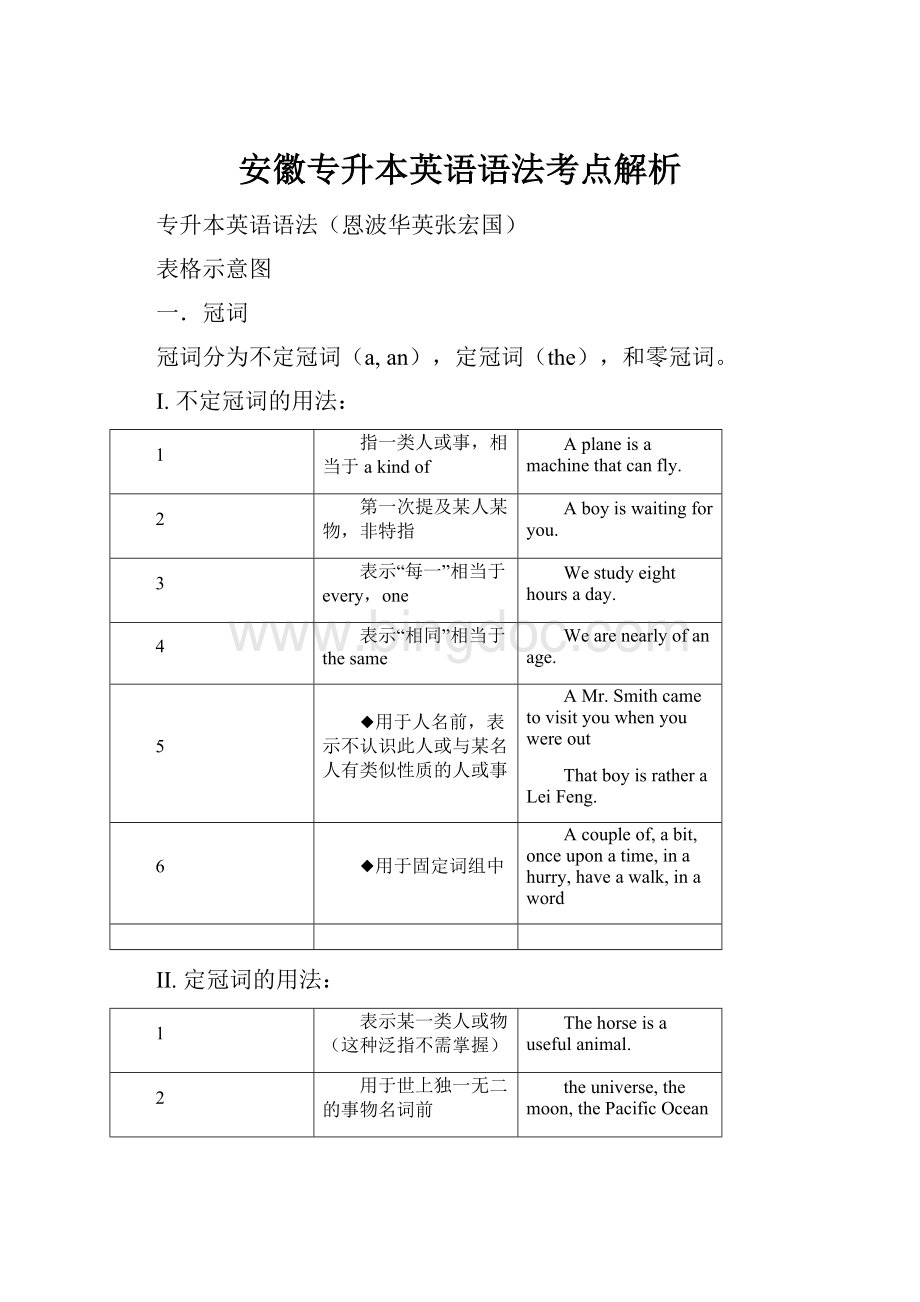安徽专升本英语语法考点解析Word文档格式.docx
《安徽专升本英语语法考点解析Word文档格式.docx》由会员分享,可在线阅读,更多相关《安徽专升本英语语法考点解析Word文档格式.docx(69页珍藏版)》请在冰点文库上搜索。

Heisthetallerofthetwochildren.
8
用于国家党派等以及江河湖海,山川群岛的名词前
theUnitedStates,theCommunistPartyofChina,theFrench
9
◆在逢十的复数数词之前,指世纪的某个年代
inthe1990’s,对比inthe1960s和inhis60s
10
◆用于表示单位的名词前
Ihiredthecarbythehour.(按小时计费)
11
◆用于方位名词,身体部位名词,表示时间的词组前
Hepattedmeontheshoulder.(the不能换成my)
III.零冠词的用法:
专有名词,物质名词,抽象名词,人名地名等名词前
BeijingUniversity,Jack,China,love,air
名词前有this,my,whose,some,no,each,every等限制
Iwantthisbook,notthatone./Whosepurseisthis?
◆季节,月份,星期,节假日,一日三餐前
March,Sunday,NationalDay,spring但theSpringFestival
◆表示职位,身份,头衔的名词前
LincolnwasmadePresidentofAmerica.
◆学科,语言,球类,棋类名词前
Helikesplayingfootball/chess.
◆与by连用表示交通工具的名词前
bytrain,byair,byland
以and连接的两个相对的名词并用时
husbandandwife,knifeandfork,dayandnight
8
表示泛指的复数名词前
Horsesareusefulanimals.
IV有无冠词的词汇或词组的对比
不可数名词的具体化用作可数名词
cloth(布料—不可数)与atablecloth(桌布);
beer(啤酒)与abeer(一杯啤酒);
glass(玻璃)与alookingglass(镜子)
◆相似词组的对比
inchargeof/inthechargeof;
incaseof/inthecaseof;
infrontof/inthefrontof;
outofquestion/outofthequestion
二、数词
I.序数词onetwothree…与基数词firstsecondthird...
II.分数onethird三分之一/twothirds三分之二…
III.数词的重要表达
Tensofmillionsof复数名词;
thousandsof复数名词;
dozensof/scoresof表示许多
Threedozeneggs三打鸡蛋;
threescorestudents六十位学生(三个20);
Aten-year-oldboy;
a300-wordcomposition;
atwo-minutedrive;
twominutes’dive
Inthesixties在六十年代/inhissixties在他六十多岁时
Agreatnumberof复数名词/thenumberof复数名词/alargeamountof不可数名词
三.代词:
I.代词可以分为以下七大类:
人称代词
主格
I,you,he,she,it,we,you,they
宾格
me,you,him,her,it,us,you,them
物主代词
形容词性
my,your,his,her,its,our,their
名词性
mine,yours,his,hers,its,ours,theirs
反身代词
myself,yourself,himself,herself,itself,ourselves,yourselves,themselves
指示代词
this,that,these,those,such,some
疑问代词
who,whom,whose,which,what,whoever,whichever,whatever
关系代词◆
that,which,who,whom,whose,as
不定代词
one/some/any,each/every,none/no,many/much,few/little/afew/alittle,
other/another,all/both,neither/either
II.不定代词用法注意点:
◆
用法示例
one
one可以泛指任何人,也可特指,复数为ones。
Oneshouldlearntothinkofothers.
some
any
1.some多用于肯定句
2.也可用于疑问句中,表示盼望得到肯定的答复,或者表示建议,请求等。
3.some和any修饰可数名词单数时,some表示某个,any表示任何一个。
4.some和数词连用表示“大约”
Ihavesomequestionstoask.
Wouldyoulikesomebananas?
Couldyougivemesomemoney?
Ihavereadthisarticleinsomemagazine.
Pleasecorrectthemistakes,ifany.
Therearesome3,000studentsinthisschool.
1.any多用于疑问句和否定句
2.some和any修饰可数名词单数时,some表示某个,any表示任何一个。
3.any可与比较级连用表示程度。
Haveyouanybookmarks?
No,Idon’thaveanybookmarks.
Doyoufeelanybettertoday?
each
every
each强调个别,代表的数可以是两个或两个以上
each可以单独使用,后面不跟名词
Eachstudenthasapocketdictionary.
Each(ofus)hasadictionary.
Weeachhaveadictionary.
every强调整体,所指的数是三个或三个以上。
every后接名词,everyone可以后接of结构
Everystudenthasstrongandweakpoints.
Everyoneofushasstrongandweakpoints.
none
no
none作主语或宾语,代替不可数名词,谓语用单数,代替可数名词,谓语单复数皆可以。
Howmuchwateristhereinthebottle?
None.
Noneofthestudentsare(is)afraidofdifficulties.
no等于notany,作定语。
Thereisnowaterinthebottle.
other
another
other泛指“另外的,别的”常与其他词连用
theother+单数名词,特指两者中的另外一个
theother+复数名词=theothers(表示在一定范围中的其他…)
other+复数名词=others(没有范围的其他…)
如:
theotherday,everyotherweek
Heheldabookinonehandandhisnotesintheother.
Twostudentsinourclassfailed,buttheotherspassedtheexam.(ourclass是一个明确的范围)
Somelikefootball,whileotherslikebasketball.
another指“又一个,另一个”无所指
Thetrousersaretoolong.Pleasegivemeanotherpair.
all
both
either
neither
none
all+复数名词,表示三个或以上概念
all表示不可数名词时,其谓语动词用单数。
both+复数名词,表示两个
either+单数名词,表示两个中的一个
neither表示两个都不
none表示三个或以上都不
全部否定用neither和none.(表示“都不是”)
(both/all与not搭配表示“不都是”)
AllofthebooksarenotwritteninEnglish.
Allthatglittersisnotgold.(发光的不都是金子。
)
Bothofusarenotteachers.我们俩不都是教师。
Eitherofthetwoanswersisacceptable.
Neitherofusisateacher.我们俩都不是教师。
Noneofusis/areateacher.我们都不是教师。
四.形容词和副词
I.形容词:
1.形容词的位置:
1)形容词作定语通常前置,但在下列情况后置:
修饰some,any,every,no和body,thing,one等构成的复合不定代词时
nobodyabsent,everythingpossible
alive,alike,awake,aware,asleep等可以后置◆
theonlypersonawake
和空间、时间、单位连用时
abridge50meterslong
形容词短语一般后置
amandifficulttogetonwith
2)多个形容词修饰同一个名词的顺序:
代词
数词
性状形容词
冠词前的形容词
冠词
代词所有格
序数词
基数词
性质
状态
大小
长短
形状
新旧
温度
颜色
国籍
产地
材料
质地
名词
all
such
the
a
this
your
second
next
four
beautiful
good
poor
large
short
square
new
cool
black
yellow
Chinese
London
silk
stone
◆从抽象到具体
thebeautifulsmallroundnewredChinesewoodtable
3)复合形容词的构成:
形容词+名词+ed
kind-hearted
名词+形容词
world-famous
形容词+形容词
dark-blue
名词+现在分词
peace-loving
形容词+现在分词
ordinary-looking
名词+过去分词
snow-covered
副词+现在分词
hard-working
数词+名词+ed
three-egged
副词+过去分词
newly-built
数词+名词
twenty-year
II.副词
1.副词的分类:
时间副词
soon,now,early,finally,once,recently
频度副词
always,often,frequently,seldom,never
地点副词
here,nearby,outside,upwards,above
疑问副词
how,where,when,why
方式副词
hard,well,fast,slowly,excitedly,really
连接副词
how,when,where,why,whether,however,meanwhile
程度副词
almost,nearly,very,fairly,quite,rather
关系副词
when,where,why◆
2.几个副词的用法◆
so/how/too
so/how/too+adj./adv.
Itissohotaday./Howhottheweatheris!
/Itistoodifficultaquestion.
what/such
what/such+(adj.)noun
Itissuchahotday./Itissuchhotweather./Whatahotdayitis!
enough
enough+noun
adj./adv.enoughtodo
Ihaveenoughmoneytobuyahouse.
Heisoldenoughtojointhearmy.
however
表“但是”,用逗号隔开
注意与while的区别
Somepeopleagree.However,othersdisagree.
=Somepeopleagreewhileothersdisagree.
almostnot与notnearly
high可测量的高度
highly抽象的高度
too肯定句中的“也”
either否定句中的“也”
III.◆形容词和副词比较等级:
形容词和副词的比较等级分为原级,比较级和最高级。
比较级和最高级的构成一般是在形容词和副词后加-er和-est,多音节和一些双音节词前加more和most。
同级比较时常常用as…as…以及notso(as)…as…如:
Iamnotsogoodaplayerasyouare.
可以修饰比较级的词有:
much,alot,even,far,abit,alittle,still,yet,byfar,any,agreatdeal。
表示一方随另一方变化时用“themore(主谓)themore(主谓)”句型。
Theharderyouwork,themoreprogressyouwillmake.
用比较级来表达最高级的意思。
Ihaveneverspentamoreworryingday.
表示倍数的比较级有如下几种句型:
Ourschoolisthreetimeslargerthanyours./
Ourschoolisfourtimesaslargeasyours./Ourschoolisfourtimesthesizeofyours.
–以or结尾的形容词,本身含有比较的含义,所以不能用-er或more/less构成比较级,其后加to.如besuperior/inferior/junior/senior/major/minor/prior/posteriorto
7◆
特殊结构notsomuchAasB(不是A,而是B);
nomorethan仅仅;
aswellas/assoonas/as(so)longas/asfaras
wouldratherdoratherdo(宁愿…而不愿意…);
ratherthan而不是/otherthan除了;
cannot(never)…too越…越好
五.介词
I.介词分类:
简单介词
about,across,after,against,among,around,at,below,beyond,during,in,on
合成介词
inside,into,onto,outof,outside,throughout,upon,within,without
短语介词
accordingto,becauseof,insteadof,upto,dueto,owingto,thanksto
双重介词
fromamong,frombehind,fromunder,tillafter,inbetween
分词转化成的介词◆
concerning(关于),given(鉴于)
II.常用介词区别:
表示时间的in,on,at
at表示片刻的时间,in表示一段的时间,on总是与日子有关
表示时间的since,from
since指从过去到现在的一段时间,和完成时连用,from指从时间的某一点开始
表示时间的in,after
in指在一段时间之后,after表示某一具体时间点之后或用在过去时的一段时间中
表示地理位置的in,on,to
in表示在某范围内,on指与什么毗邻,to指在某环境范围之外
表示“在…上”的on,in
on只表示在某物的表面上,in表示占去某物一部分
表示“穿过”的through,across
through表示从内部通过,与in有关,across表示在表面上通过,与on有关◆
表示“关于”的about,on
about指涉及到,on指专门论述
between与among的区别
between表示在两者之间,among用于三者或三者以上的中间
besides与except的区别◆
besides指“除了,包括在内”,except指“除了,不包括在内”,beside在…旁边
表示“用”的in,with
with表示具体的工具,in表示材料,方式,方法,度量,单位,语言,声音
as与like的区别
as意为“作为,以…地位或身份”,like为“象…一样”,指情形相似
12
in与into区别
in通常表示位置(静态),into表示动向,不表示目的地或位置
III.重要的介词
1.介词的意思◆
across(穿过;
在对面);
against(反对、在…….衬托下、靠着);
beyond(超出);
等
2.介词的搭配◆
resultin导致/resultfrom由…导致;
befamousfor/as/to;
befamiliarto/with;
bedifferentfrom/in;
besimilarto/in;
inthemorning/onTuesdaymorning;
whatfor;
prevent/stop/keepsbfromdoing;
protectsbfromdoing;
等等
Onseeingthepicture,heburstintotears./Atthesightofthepicture,heburstintotears.
Hewillbebackinfivedays./Afterfivedays,hereceivedarewardfromthegovernment.
itisimportant/necessary/easy/difficult/convenientforsbtodo;
itiskind/considerate/thoughtful(表示人性格的词汇)ofsbtodo
(=sbiskind/considerate/thoughtfultodosth.)
六.名词(数、格、主谓一致)
I.名词的种类:
专有名词
普通名词
国名地名人名,团体机构名称
可数名词
不可数名词
个体名词
集体名词
抽象名词
物质名词
II.名词的数:
1.规则名词的复数形式:
名词的复数形式,一般在单数形式后面加-s或-es。
现将构成方法与读音规则列表如下:
规则
例词